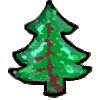Morphotaxon of woody coniferophyte vegetative shoots with irregular branching, bearing helically arranged polymorphic, simple, bifid and multifid leaves. Leaves closely arranged on ultimate and penultimate branches , more distantly spaced on antipenultimate branches and absent from largest stems. Stem surface rugose with thick cuticle and round to tangentially oriented oval branch scars, longitudinally disposed subtle wavy ridges on apparently decorticated stem surfaces. Leaves decurrent and broadly attached, with one to eight dichotomizing veins, each vein forming an adaxial ridge and terminating in an obtuse to narrowly acute point. Simple leaves 4-16 mm long and 0.2-2.2 mm wide, lanceolate to ovate-lanceolate ; bifid leaves 4-13 mm long and 0.5-4.0 mm wide, obovate to lanceolate with short teeth, or more deeply dissected with spreading tips; multifid leaves 5-25 mm long and 2.0-6.1 mm wide, deltoid - cuneate with serrate distal margin. Lateral leaf margins with unequally dispersed trichomes, more densely arranged near leaf bases. Leaves epistomatic; relatively smooth abaxial surface of longitudinally elongated cells with smooth margins and transverse-oblique end walls; adaxial surface papillate with irregularly oriented stomata in wide bands, smooth rectangular cells between bands and near lateral margins. Haplocheilic, monocyclic or incompletely monocyclic stomatal complexes round to oval and axially elongate with four to seven subsidiary cells; overarching papillae more or less
developed on subsidiary cells. Dense wood of narrow tracheids with mostly uniseriate, circular to oval bordered pits with oval apertures on radial walls; uniseriate rays one to three cells
high. Reproductive structures unknown.
Buriadia heterophylla Seward and Sahni
nomenclatorial act:
emend.
Page:
27
diagnosis:
systematic position:
As a result of the discoveries that (1) all of the presently known material of Buriadia (including specimens described as Birsinghia florinii) conform to a single range of structural variation, and (2) none of the horned seeds associated with any of the specimens described as Buriadia heterophylla or Birsinghia jlorinii are attached to the leafy shoots, we now realize that there is no evidence for the reproductive structures of this species. Therefore, following the International Code of Botanical Nomenclature (Greuter et al., 2000), Buriadia heterophylla is a morphotaxon of vegetative coniferophyte remains.
typeseries:
Lectotype: Small leafy shoot designated as the lectotype of Buriadia heterophylla by Florin (1945, p. 311) for a specimen illustrated by Feistmantel (1879-1881 , PI. XXIII, fig. 4). That specimen (No. 5/45 from the Karharbari beds at Buriadi) is housed at the Geological Survey of India, Calcutta, and also has been figured by Seward and Sahni (1920, PI. 11, fig. 20). Not realizing that Florin (1945) had formally lectotypified Buriadia heterophylla, Pant and Nautiyal (1967) later chose a larger branched specimen (i.e. specimen no. 5/43=5043, also housed at the Geological Survey of India, Calcutta) to lectotypify the species. Three different versions of that specimen have been illustrated previously. It was first illustrated by a drawing in Feistmantel (1879-1881, PI. XXIII, fig. 2; our Plate V, 1). A photograph of the 'partly restored ' specimen was figured by Sahni (1928, PI. I, fig. 1; our Plate V, 3), and a second drawing of the 'partly restored ' specimen was presented by Pant and Nautiyal (1967, figure 79A; our Plate V, 2). In this paper we follow Florin's earlier lectotypification of the species B. heterophylla.
Classification:

Add new comment